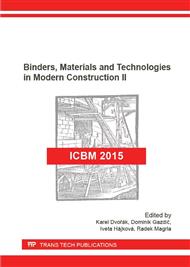p.141
p.145
p.151
p.157
p.162
p.167
p.171
p.178
p.183
Assessment of the Aggregate in Historical Plasters
Abstract:
This article deals with the analysis of the aggregates of historical plasters. In the paper there is described the assessment methodology of the aggregates of historical plasters. The assessment of the aggregates is carried out with the example of a set of original and modern-day aggregates taken in the prelature and convent of the Želiv Monastery. Composition of fine aggregates of historical plasters was compared to the composition of the aggregates from resources of nearby watercourses. As well as it was assessed the geological character of nearby vicinity of the Monastery. For the analysis of character of the plaster fine aggregates it is applied the optical microscopy of the plaster thin sections, grain size analysis, mineralogical and petrographic analysis of the aggregates. The presented results document the differences in the origin of the aggregate used in plasters.
Info:
Periodical:
Pages:
162-166
Citation:
Online since:
August 2016
Authors:
Keywords:
Price:
Сopyright:
© 2016 Trans Tech Publications Ltd. All Rights Reserved
Share:
Citation:


